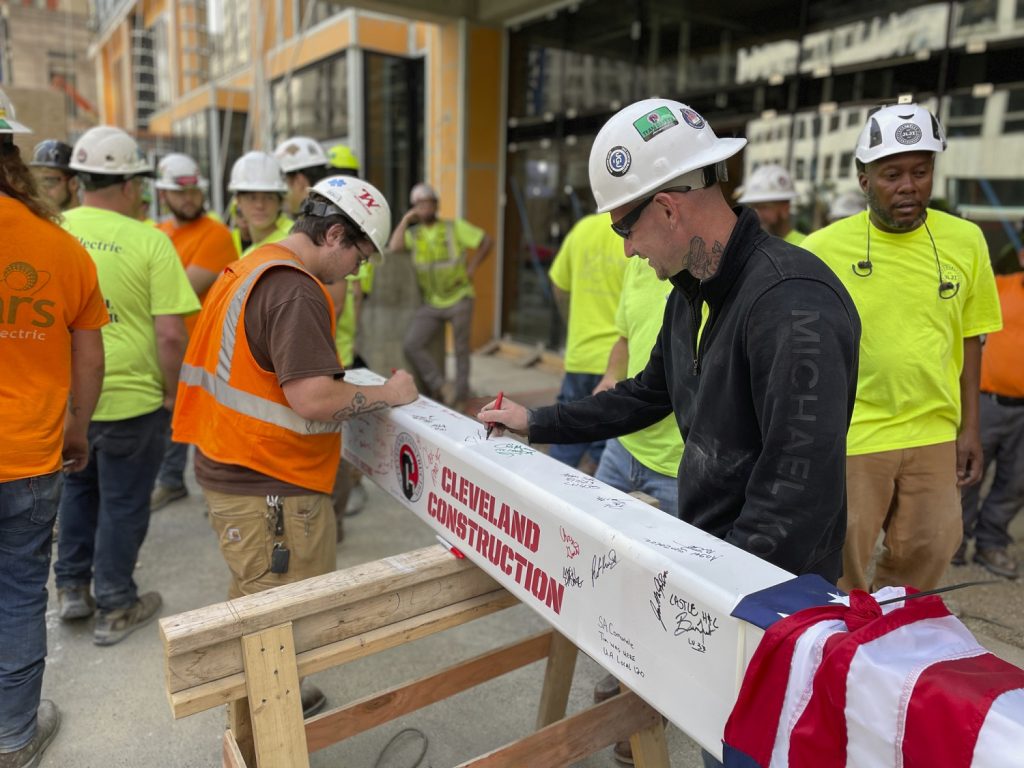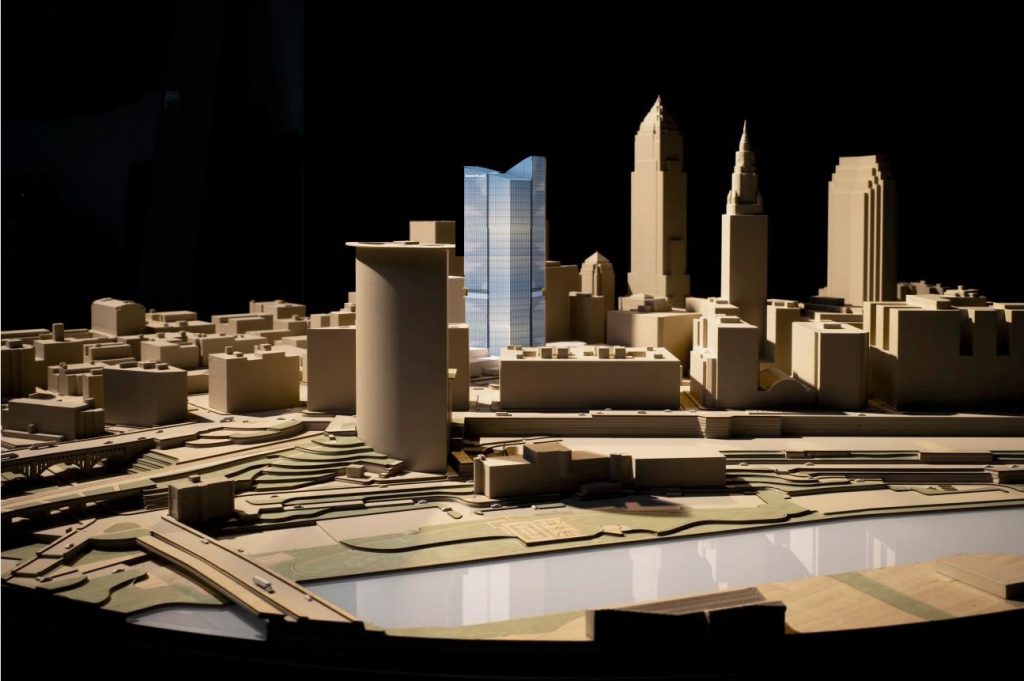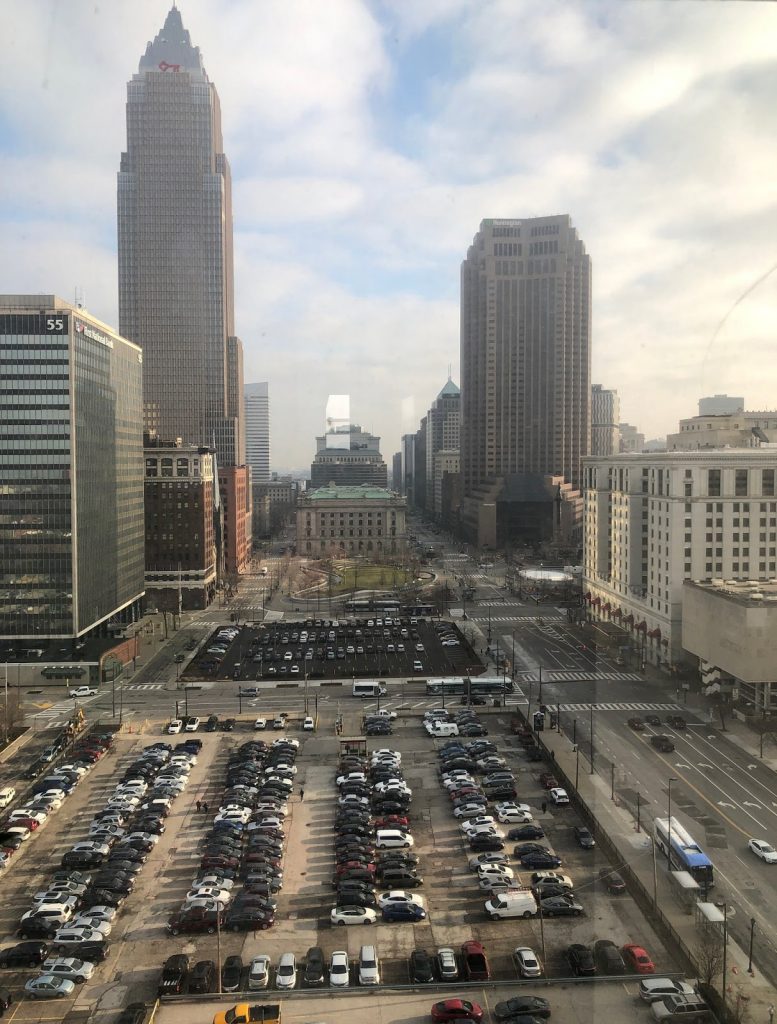Skyline-changing legislation has suddenly sparked back to life in the Ohio legislature. Substitute Senate Bill 39, to create a tax credit for insurance companies to invest in Transformational Mixed Use Developments (TMUDs), could aid several big real estate developments in Cleveland.
If the legislation continues on what appears to be a new, fast track, it could become law as early as next month.
There was little visible activity surrounding Sub. SB 39 since it passed the Ohio Senate 32-1 on June 25. It was introduced into the House of Representatives the following day. But there had been no action on the bill since it was referred to the Economic & Workforce Development Committee on June 30.
That changed this month when three hearings were scheduled, with Sub. SB No. 39 being the only legislation on the committee’s docket. The bill could be reported out of the committee as early as Oct. 30 or Nov. 6 for a vote by the full House, with as many as a half dozen House sessions available in November for the House to pass it.
The House may move the bill quickly as it had already passed a similar bill, House Bill 469, last year by a 91-0 vote. It came after six hearings over two months in the House Government Accountability and Oversight Committee. But the legislative session expired before the Senate could pass it.
Originally drafted by Thompson Hine LLP at the request of Stark Enterprises, the legislation would allow an insurance company investor to fill a missing piece in the capital stack for Stark’s nuCLEus development in downtown Cleveland. In fact, a source said the $350 million, 2-million-square-foot project couldn’t move forward without it.
Perhaps coincidentally, and with the legislation showing promise of passage, Stark’s real estate broker Cresco released on Oct. 22 a new nuCLEus presentation with more detailed images about the project.
The presentation heavily promoted the office building, more half of which is already spoken for by prospective tenants. And it promoted specific retail spaces, the rentable areas of those spaces, and noted that the spaces would become available in “March 2020.” While tax abatement is available from the city for residential real estate it is not available for commercial development.
Ezra Stark, chief operating officer, of Stark Enterprises did not respond to an e-mail seeking comment for this article.
NuCLEus is proposed to feature two 24-story buildings, one for residential and the other for offices, atop a muli-story pedestal of parking and retail between Prospect Avenue and Huron Road at East 4th Street. NuCLEus is pursued by a partnership called Gateway Huron LLC, comprised of Stark Enterprises and J-Dek Investments Ltd.
For a development to be considered a TMUD it must include a mix of land uses, have a development cost of more than $50 million and be 15 or more stories in height or at least 350,000 square feet. The bill authorizes a nonrefundable insurance company tax credit of up to 10 percent of total eligible project costs for contributions of capital to eligible projects.
NuCLEus would likely qualify, but a number of TMUD credits per year still has to be authorized by budget corrections language that has yet to be introduced to the Ohio General Assembly. Then, nuCLEus would have to be one of the limited number of projects certified by the state’s Director of? Development Services as eligible for the tax credit.
Ohio Senator Kirk Schuring (R-29, Canton) is sponsoring Sub. SB 39. The bill has 18 bipartisan co-sponsors. Schuring delivered his sponsor testimony Oct. 16 to the House Government Accountability and Oversight Committee.
“Sub. SB 39 will have a catalytic effect on the surrounding areas where these mega projects are constructed,” Schuring testified. “It will trigger an economic chain reaction that truly will be transformational, fostering new retail establishments, new office buildings, new residential facilities and new entertainment venues. In short, it will be a vibrant place where people will want to live, work and play.”
It isn’t known if the new Sherwin-Williams (SHW) headquarters and research & development facilities, likely to be built in downtown Cleveland, would be eligible for the TMUD tax credit. It has been assumed that SHW would pay for the roughly $1 billion project from its own significant net cash flow, which is nearly $2 billion per year.
But if an insurance company did invest in SHW’s new HQ+R&D under the TMUD program, it could create a roughly $100 million public incentive to build the anticipated 1.8-million-square-foot project in Ohio. Sources say that up to $200 million in public incentives from the city, county and state were pledged to SHW to build its new HQ+R&D in Cleveland.
A week after Senator Schuring testified, on Oct. 23, Frank Sinito, CEO of Cleveland-based Millennia Group of Companies, testified before the committee that redevelopment of its 1.3-million-square-foot Centennial building couldn’t happen without Sub. SB 39. The Centennial is the former Huntington Bank building at 925 Euclid Ave.
He noted that, as opposed to new construction, the redistribution of mechanical, electrical, plumbing and other circulation systems throughout an existing building is extremely challenging and “far exceeds” the cost of new construction.
The renovation of existing buildings often results in much lower efficiency factors in the range of 65 percent as opposed to new construction which is usually 85 percent and above. Of the 1.3 million square feet in The Centennial, over 350,000 square feet is non-income producing circulation and other space.
“The rents from the other income-producing areas of the building simply are not sufficient to subsidize the costs associated with these very large but non-income-producing areas of the building,” Sinito testified.
“So, given these realities, it is very important to see — and I think it becomes quite clear — that existing buildings often have an even greater need for the type of financial assistance that SB 39 is intended to provide than new construction does,” he added.
In his testimony before the Senate Finance Committee in April, Stark Enterprises CEO Robert Stark said that the TMUD tax credit wouldn’t be a replacement for the limited-duration and since-expired “catalytic” historic tax credit. Instead, it would apply equally to new construction and foster investment in the future of Ohio’s cities.
“We’re seeing an international phenomenon of re-urbanization,” Stark said. “We’re faced with attracting and keeping the best and the brightest. To do that requires a culture of an interconnected, collaborative society and undoing the isolationism of sprawl.”
END











Another fabulous article, Ken. Let's hope that the transformative nuCLEus project finally gets underway.
Lets hope they pass this bill without anymore delays. Starting Nucleus AND extending these TMUD tax credits additionaly to S W would be even one more incentive to keep Sherwin Williams downtown
Sherwin Williams isn't leaving especially with Cleveland creating that microgrid downtown